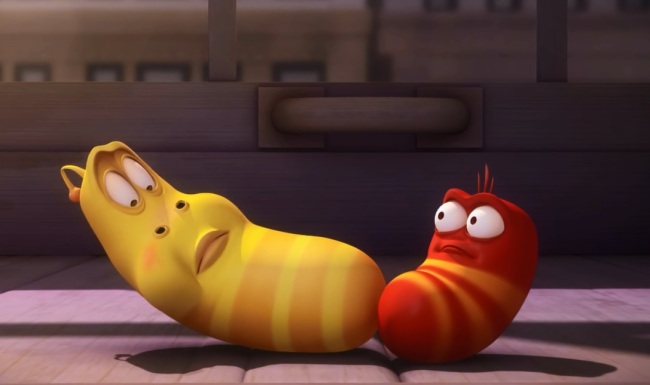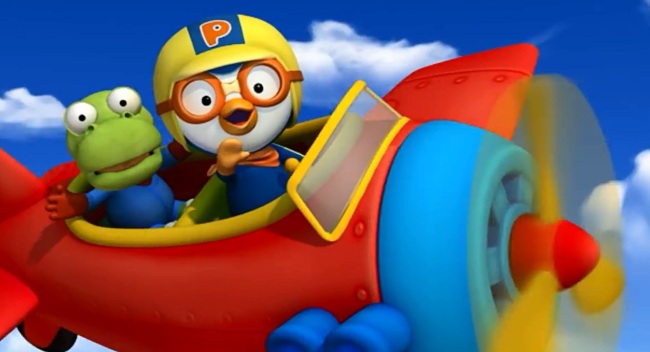‘Pororo,’ ‘Larva’ change game in Korean animation
By 줄리 잭슨 (Julie Jackson)Published : Sept. 4, 2015 - 14:41

Up until the turn of the 21st century, many Korean youngsters who plopped in front of their television sets found themselves regaled with delightfully innocent tales of popular international cartoon series such as “Dragon Ball Z,” “Sailor Moon” or “Tom and Jerry” with their rambunctious games of cat and mouse.
A couple of decades ago -- in the pre-“Pororo” era of Korean animation -- TV cartoon options for Korean children were mainly limited to the adventures of the locally grown Dooly the magical little dinosaur or cartoon series imported from Japan.
Created in 1983, Dooly became the most commercially successful character of South Korean animation during its time. Nevertheless, minus animator Kim Soo-jung’s green dino success story, most local children were left with few options but to find entertainment in series that were imported from overseas markets, most notably programs and characters from global animation leaders Japan and the U.S.
However, all this underwent an unforeseen change in 2003 thanks to the creation of the Korean cartoon industry’s biggest triumph -- “Pororo the Little Penguin.”
What started off as a small-time animation by Choi Jong-il, about the playful adventures of a little penguin and his animal friends, ended up propelling the local animation industry into uncharted waters. The lovable penguin has now become the most popular character in Korea, even being dubbed the “children’s president.”
The phenomenal success of the local “Pororo” cartoon series has now changed the way major distributors view South Korean animation. To date, the cartoon series has been exported to some 120 countries. Its originator Choi once publicly stated that he predicts Pororo’s overseas sales will outpace its domestic sales by 2020.
A couple of decades ago -- in the pre-“Pororo” era of Korean animation -- TV cartoon options for Korean children were mainly limited to the adventures of the locally grown Dooly the magical little dinosaur or cartoon series imported from Japan.
Created in 1983, Dooly became the most commercially successful character of South Korean animation during its time. Nevertheless, minus animator Kim Soo-jung’s green dino success story, most local children were left with few options but to find entertainment in series that were imported from overseas markets, most notably programs and characters from global animation leaders Japan and the U.S.
However, all this underwent an unforeseen change in 2003 thanks to the creation of the Korean cartoon industry’s biggest triumph -- “Pororo the Little Penguin.”
What started off as a small-time animation by Choi Jong-il, about the playful adventures of a little penguin and his animal friends, ended up propelling the local animation industry into uncharted waters. The lovable penguin has now become the most popular character in Korea, even being dubbed the “children’s president.”
The phenomenal success of the local “Pororo” cartoon series has now changed the way major distributors view South Korean animation. To date, the cartoon series has been exported to some 120 countries. Its originator Choi once publicly stated that he predicts Pororo’s overseas sales will outpace its domestic sales by 2020.

Looking to jump on the bandwagon of the country’s next big-hit animation character has led to the birth of numerous new cartoon faces, including one of Korea’s latest mass-scale animation trends -- the ridiculously goofy, nonverbal larvae characters of “Larva.”
First introduced in 2011, Larva revolves around the adventures and tales of two larva characters, whose personality traits are just the opposite. Yellow is the happy-go-lucky yellow-colored larva who’s a tad slow on the uptake, while sidekick Red is a red-colored larva who is mean-spirited and derives joy from playfully abusing his pal.
Starting out only as short, 90-second animation clips with zero verbal dialogues, the series surprised as an instant success and has already been sold to 40 countries.
Much like the path of “Pororo,” the almost uncomfortable funny-looking larvae characters have leaped out of the TV screens and on to practically everything.
The faces of “Larva” now can be seen adorning the exterior and interior of buses, subways, backpacks, phones, pillows and just about everything to the point where one can’t turn a head in Seoul without catching a glimpse of either a cutesy blue penguin or big-eyed wormy creatures.
Korea’s animation success has been on a steady incline over the past decade, further strengthening its reputation in the global animation market and shows no signs of tapering.
According to statistics from KOCCA, the Korean animation character industry has increased on average more than 7 percent a year since 2008 and is expected to continue its upward trajectory.
By Julie Jackson (juliejackson@heraldcorp.com)
First introduced in 2011, Larva revolves around the adventures and tales of two larva characters, whose personality traits are just the opposite. Yellow is the happy-go-lucky yellow-colored larva who’s a tad slow on the uptake, while sidekick Red is a red-colored larva who is mean-spirited and derives joy from playfully abusing his pal.
Starting out only as short, 90-second animation clips with zero verbal dialogues, the series surprised as an instant success and has already been sold to 40 countries.
Much like the path of “Pororo,” the almost uncomfortable funny-looking larvae characters have leaped out of the TV screens and on to practically everything.
The faces of “Larva” now can be seen adorning the exterior and interior of buses, subways, backpacks, phones, pillows and just about everything to the point where one can’t turn a head in Seoul without catching a glimpse of either a cutesy blue penguin or big-eyed wormy creatures.
Korea’s animation success has been on a steady incline over the past decade, further strengthening its reputation in the global animation market and shows no signs of tapering.
According to statistics from KOCCA, the Korean animation character industry has increased on average more than 7 percent a year since 2008 and is expected to continue its upward trajectory.
By Julie Jackson (juliejackson@heraldcorp.com)



















![[Today’s K-pop] BTS pop-up event to come to Seoul](http://res.heraldm.com/phpwas/restmb_idxmake.php?idx=642&simg=/content/image/2024/04/17/20240417050734_0.jpg&u=)